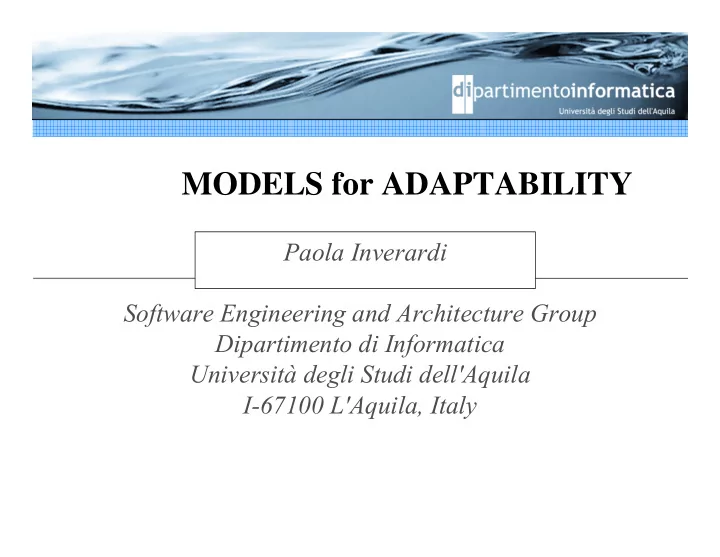

MODELS for ADAPTABILITY Paola Inverardi Software Engineering and Architecture Group Dipartimento di Informatica Università degli Studi dell'Aquila I-67100 L'Aquila, Italy
What are Models? An idealized view of the system suitable for reasoning, » developing, validating a real system Better if formal , e.g. rigorous, mathematical-logical » flavour, etc. SEA Group SEAMS 2006 2
WHAT is ADAPTABILITY? The ability to change a system according to context » variations, e.g. driven by QoS requirements SEA Group SEAMS 2006 3
ADAPTABILITY II But …Still remaining the same » » Adaptability makes sense only if it preserves something …the Invariant SEA Group SEAMS 2006 4
A more serious example What is the invariant here? » The surface surface SEA Group SEAMS 2006 5
Even better/worse Invariant ??? » The 3D function function SEA Group SEAMS 2006 6
A more familiar example … (Tivoli-Inverardi) Connector Free Architecture Component 1 Component 3 Structure changes – equivalent behavior Component 2 local views of each component Component 1 Component 1 Component 3 Component 3 Component 1 Component 3 Connector code deadlock-freeness Behavioral property Deadlock-free Connector Failure-free Connector Connector (assembly code) Component 2 Component 2 Component 2 SEA Group SEAMS 2006 7 Failures-free Connector Based Architecture Deadlock-free Connector Based Architecture Connector Based Architecture
What are the models and fomalisms » An architectural model i.e. constraints on the way components can interact » Behavioural model for components -- LTS » Behavioral equivalence on LTS » Temporal logic – Buchi Automata » Model Checking SEA Group SEAMS 2006 8
Ex. 2 - PERFORMANCE : system reconfiguration Caporuscio-Di Marco-Inverardi Reconfigure it dynamically We want to … Monitor its performance Running software application a framework We reach our aims by means of … Decide its next running configuration SEA Group Non SEAMS 2006 9
PERFORMANCE : system reconfiguration The LIRA framework (Castaldi-Carzaniga-Inverardi-Wolf) SEA Group SEAMS 2006 10
Which models? » System dynamic model (LTS etc) » Queueing Network models (+-extended) derived from the dynamic models » Models analysis » Performance indices evaluation SEA Group SEAMS 2006 11
First conclusion – 1 -- » Models for adaptability must be able to express the invariant essence of the system not the variable one … » Easier for structure : - topological constraints (Jeff&Jeff) - Graph grammars (Le Metayer, etc.) - Category Theory (Fiadeiro-Maibaum etc.) What about behavior? SEA Group SEAMS 2006 12
Invariant -- continue Behavioral/Semantics invariance Difficult in general: non-computable � restrictions Examples : - Type systems (can be also structure … ArchJava) - Behavioral equivalence checks (Allen&Garlan , process algebras) better preorders - Models checking and evaluation - Constraints programming - Code/component certification – Proof Carrying Code SEA Group SEAMS 2006 13
An orthogonal issue: Static VS Dynamic » Is adaptability static or dynamic? The system adapts at run time how and when the adaptation is computed does not change the problem it is just a matter of cost . Cost of the adaptation that maintains the invariant. At the end it is just a pointer in the control link stack … The real issue is what is the invariant and how do we maintain it? Ex. Functional Languages and Higher order functions (a’ la ML) (ponlimorphic types, type inference) SEA Group SEAMS 2006 14
Following the 3D function example Build the n-dimension space � fix in the context the variable points that matter Design the overall system with all its possible fluctations. extract/ elicit the function, i.e. the non variable non variable essence of the system Example: If we consider a service and a QoS space that can dynamically vary then the function is the “optimal “ correlation among the points in the space to achieve the “best” overall QoS SEA Group SEAMS 2006 15
An initial attempt to rephrase all this » S = software system SS = Static description of S { the code, the structure of the code, » the language it has been written, the developing artifact, the language in which it is described and all the models that can from these information be deduced (control flow graphs, slicing models, etc.)} D = {behavior of S} dynamic description of S » C = {description of the running context} c ∈ C (might not » be under the system control, otherwise just an input) » <i> = input (known variability points) R ⊆ D x D R suitable equivalence relation on D . R » » R SEA Group SEAMS 2006 16
Formalization 2 --- Re-configuration Re-Configuration Let Γ be the set of configurations γ = <SS, c, <i>> Def. Let → reconf ⊆ Γ x Γ such that γ → reconf γ ’ iff SS γ ≠ SS’ γ ’ re-configuration requires a change in the structure of S, formalizes the context and monitors the execution environment. SEA Group SEAMS 2006 17
Formalization 2 --- Adaptability Adaptation S can be adapted to S’ wrt an equivalence R R if <SS, c, <i>> → reconf <SS’, c, <i>> (SS ≠ SS’) and D R R D’. R can assess functional or non functional properties R More appropriately R R should be a congruence relation that preserves contexts of use of the system thus modeling the user’s observable view In other words we require that adaptation implies a change in the static structure of the system. (e.g. we do not consider weak adaptation as adaptation) SEA Group SEAMS 2006 18
Conclusions Many dimensions to consider Cost/Validation Behavior Structure/constraints SEA Group SEAMS 2006 19
My opinion: Focus on Invariants » Structure Software architectural models/Styles, patterns, etc. » Behavior Abstract behavior, Types/signatures, Behavioral equivalences » Cost/Validation Interplay between static and dynamic analysis, clients and servers, compiled and interpreted SEA Group SEAMS 2006 20
Do not stop looking for models … may be that … Under the formal suite also models … …. have an heart … SEA Group SEAMS 2006 21
References » Woss proceedings SEA Group SEAMS 2006 22
Recommend
More recommend